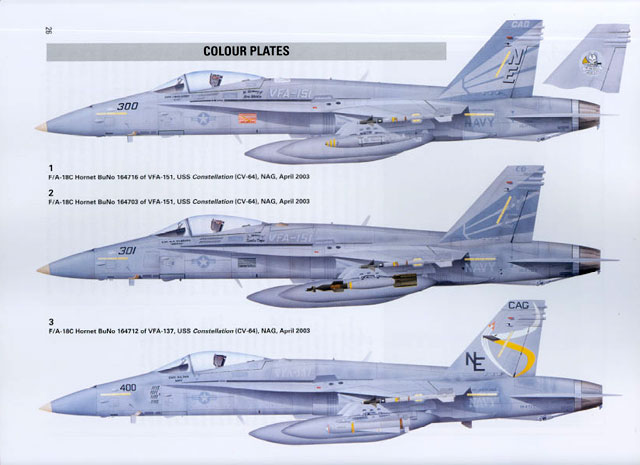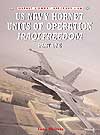S u m m a r y\
|
| Publisher and
Catalogue Details: |
Osprey Combat Aircraft
No. 46
US Navy Hornet Units of Operation Iraqi Freedom Part 1 by
Tony Holmes |
| ISBN: |
1841768014 |
| Media and
Contents: |
Soft cover, 96 pages |
| Price: |
GB£12.99 online from Osprey Publishing |
| Review Type: |
FirstRead |
| Advantages: |
Excellent coverage of
subject matter from the perspective of those involved.
Highly accurate and informative text |
| Disadvantages: |
|
|
Recommendation: |
Very Highly Recommended
|
Reviewed by Ken Bowes

Osprey's US Navy Hornet Units of Operation
Iraqi Freedom Part 1
will be availale online from Squadron.com
Osprey Publications Aerospace editor and Naval Aviation
aficionado Tony Holmes is just publishing the first in a series of books
covering US Navy Hornet operations during Operation Iraqi Freedom.
Combat Aircraft Series Number 46 is focused on the use of the F/A-18
Hornet and Super Hornet by Carrier Air Wings operating in the Northern
Arabian Gulf (NAG) during the period leading up and during the Iraq War.
It is the first of three volumes covering US Navy, Marine and RAAF use
of the Hornet in Iraqi Freedom, with the second volume to cover
Mediterranean based carriers and the third land based use by the USMC
and RAAF. Tony Holmes is a noted aviation writer and photojournalist and
has a long track record publishing for Osprey including launching and
editing the Aircraft of the Aces series. He obvious knowledge of the
subject and list of credits citing many veterans of the conflict ensured
a detailed and accurate account of the operation from the perspective of
the Hornet Community. I have been greatly looking forward to this book
for some time and was not disappointed when it arrived in the mail for
review.
So what do you get in the 96 pages of this volume. The author has
sensibly broken down the subject area in order to cover as much
territory as possible. This is essential, as the Hornet was the strike
aircraft of choice in OIF, with some 250 being deployed vice the 130 odd
F-16s and 90 F-15C/Es from the USAF. The book sets the scene with a
quick review of Operation Southern Watch and the road to war,
highlighting the metamorphosis into Southern Focus as the US prepared
the battlefield of southern Iraq in late 2002 and early 2003. Subject
areas touched upon include the increased use of JDAM as a weapon of
choice for Response Options and the retasking of the USS Lincoln to
return to the NAG over the summer of 2002/3 which was so prominently
covered on Australian television as it sat off the coast of Western
Australia being replenished for war.
The second chapter of the book is titled “Shock and Awe” and covers
strike ops conducted by Hornets in the first days of OIF. Many first
person accounts are included and to my mind make the book. It was one
thing to plan the campaign and assess the results as mission reporting
and tapes were returned, it is another to get inside the minds of the
guys who did the real dirty work. It is hard to imagine how concentrated
the mind is when flying into one of the densest air defence environments
in the world around Baghdad, but the frank descriptions from both strike
leads and ordinary line pilots goes a long way to understanding the
human aspect of air warfare. Through this section the reader also gets
an idea of the complex process required to coordinate modern air
campaigns, from the Combined Air Operations Centre (CAOC) at Prince
Sultan Air Base, down to the air wings aboard ship. Explanations are
easily followed and venture into some of the defining aspects of the OIF
air war, including the prosecution of time critical targets.

The real meat of Hornet operations in OIF was providing close air
support (CAS) to the advancing Marines and US Army V Corps units.
Chapter 3 “Shaping the Battlefield” deals with this aspect of the war,
providing an outline of how tasking came from the troops in the field,
via ground or airborne Forward Air Controllers to the waiting tactical
jets. Again first person accounts are used extensively to illustrate the
points made. However clear and concise text leaves the reader with no
doubt as to what is being discussed by the aircrew, with explanations of
Kill Boxes and FAC processes provided to put a pilots story into
context. This chapter also extensively deals with the second major blue
on blue of the air war, when Lt Nathan White was shot down and killed by
a Patriot SAM near Karbala. The author has been careful not to
sensationalise this aspect of OIF, but does put the incident into
context, covering some of the theories as why the shoot-down occurred
and outlining the steps taken to prevent it reoccuring. The final
chapter “Super Hornets in OIF” closes out the book with a look at the US
Navy’s newest aircraft and it’s combat record. Whilst addressing the
importance of the “five wet” tactical tanker ops undertaken by some
Super Hornets, the author goes some way to addressing the mistaken
perception that this was the major contribution of the type to OIF.
This book has strong appeal to all those who have an interest in the
most recent Middle-East War and a desire to learn about the state of the
art of modern US Naval air power. A single appendix provides details of
all NAG based Hornet units by carrier and air wing. No scale drawings of
the F-18 are included but these may come in later volumes. As usual for
Osprey Publications, 21 colour profiles fill the centre pages with some
of the more interesting colour schemes carried by the Hornet documented.
This edition also had a very high number of full colour and black and
white photographs scattered throughout, illustrating the authors points,
but also of a size and clarity useful for modelling reference.
Having read this volume I cannot wait for Ospreys
subsequent volumes on the subject of Marine and RAAF Hornets and US Navy
F-14 operations which are due out this year. The book consists of 96
pages printed on glossy paper between cardboard covers.
Very Highly Recommended.
Thanks to
Osprey Publishing for the review sample
US Navy Hornet Units of Operation Iraqi Freedom
Part 1
(Combat
Aircraft 46) |

|
| |
 |
Author:
Tony Holmes
Illustrator: Chris Davey
US Price: $19.95
UK Price: £12.99
Publisher:
Osprey Publishing
Publish Date: July 25, 2004
Details: 96 pages; ISBN:
1841768014 |
|
|
Review Copyright © 2004 by
Ken Bowes
Page Created 25 May, 2004
Last updated 25 May, 2004
Back to
HyperScale Main Page
Home | What's
New | Features
| Gallery |
Reviews | Reference
| Forum
| Search